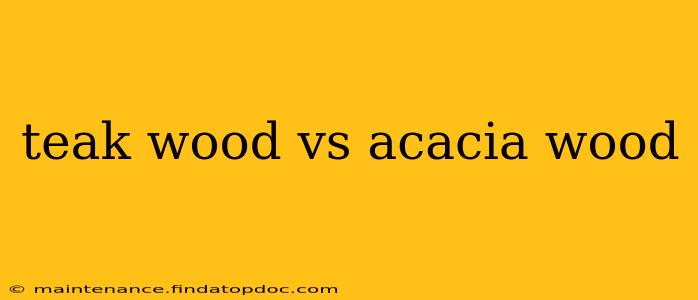Choosing the right wood for your furniture or outdoor project can be a daunting task. Two popular choices often top the list: teak and acacia. Both are known for their durability and attractive appearance, but they possess distinct characteristics that make them better suited for different applications. This detailed comparison will help you understand the key differences between teak wood and acacia wood, enabling you to make an informed decision.
What is Teak Wood?
Teak ( Tectona grandis) is a tropical hardwood prized for its exceptional durability, water resistance, and rich golden-brown color. It's naturally resistant to decay and insect infestation, making it ideal for outdoor furniture, decking, and boatbuilding. The oil content in teak wood contributes significantly to its weather resistance and longevity. Over time, teak weathers to a beautiful silver-gray patina, although many prefer to maintain its original color through oiling.
What is Acacia Wood?
Acacia (Acacia) is a genus of trees and shrubs encompassing numerous species, many of which are used for lumber. While not as consistently durable as teak, certain acacia varieties boast impressive hardness and density. It's often more affordable than teak, making it a popular choice for furniture, flooring, and even some outdoor applications. The color of acacia wood varies depending on the species and can range from light golden brown to dark reddish-brown.
Teak Wood vs. Acacia Wood: Key Differences
Here's a head-to-head comparison of teak and acacia wood across several crucial factors:
Durability and Weather Resistance
- Teak: Exceptionally durable and highly resistant to rot, decay, and insect damage. Its natural oils provide excellent protection against the elements, making it perfect for outdoor use with minimal maintenance.
- Acacia: Moderately durable and weather-resistant, but not as resistant to rot and decay as teak. While suitable for outdoor use, it may require more frequent maintenance, such as sealing or oiling, to prolong its lifespan.
Cost
- Teak: Generally more expensive than acacia due to its superior durability, slow growth rate, and sustainable harvesting challenges.
- Acacia: Significantly more affordable, making it a budget-friendly option for various applications.
Appearance and Color
- Teak: Rich, golden-brown color that weathers to a silver-gray patina. The grain is typically straight and even.
- Acacia: Color varies depending on the species but often ranges from light golden brown to dark reddish-brown. The grain can be more varied than teak.
Maintenance
- Teak: Minimal maintenance required for outdoor use, although periodic cleaning and oiling may enhance its appearance and prolong its life.
- Acacia: Requires more frequent maintenance for outdoor use, typically involving sealing or oiling to protect it from the elements.
Sustainability
- Teak: Sustainable teak sourcing is crucial. Look for certified teak to ensure responsible forestry practices. Over-harvesting has impacted teak forests in the past.
- Acacia: Many acacia species are fast-growing and readily renewable, making them a more sustainable option compared to slow-growing hardwoods like teak, provided they are sourced responsibly.
Uses
- Teak: Ideal for high-end outdoor furniture, decking, boatbuilding, flooring, and interior applications where durability and weather resistance are paramount.
- Acacia: Suitable for indoor and outdoor furniture (with appropriate treatment), flooring, cutting boards, and other applications where durability is important, but not necessarily at the level of teak.
Which Wood is Right for You?
The best choice between teak and acacia ultimately depends on your specific needs and budget.
- Choose teak if: You need exceptional durability, weather resistance, and are willing to pay a premium for a long-lasting, high-quality product. Prioritize sustainable sourcing.
- Choose acacia if: You need a more affordable option that still offers decent durability and aesthetic appeal, and are prepared to undertake more maintenance for outdoor applications.
By carefully considering these factors, you can select the wood that best suits your project and ensures lasting satisfaction. Remember to always source your wood from reputable suppliers committed to sustainable forestry practices.
Frequently Asked Questions (Based on People Also Ask)
What is the hardest wood, teak or acacia? The hardness varies within each species, but generally, teak tends to be harder than most acacia varieties. However, some acacia species can be quite hard as well. Specific Janka hardness ratings should be consulted for precise comparisons between specific species of teak and acacia.
Is acacia wood waterproof? No, acacia wood is not waterproof. While it’s more water-resistant than many other woods, it's still susceptible to water damage over time if not properly treated, especially in outdoor applications. Proper sealing or oiling is crucial for outdoor use.
Is acacia wood good for outdoor furniture? Acacia can be good for outdoor furniture, but it requires regular maintenance such as sealing or oiling to protect it from moisture and the elements. Teak is a far superior choice for outdoor furniture without this ongoing maintenance.
Does acacia wood rot? Yes, acacia wood can rot if exposed to prolonged moisture without proper treatment. The risk of rot is higher than with teak.
Is acacia wood durable? Acacia wood is moderately durable. Its durability is significantly less than that of teak. The exact durability depends on the specific acacia species.
This in-depth comparison should help you make the best choice for your next woodworking project! Remember to always consider sustainability and responsible sourcing when selecting your lumber.
